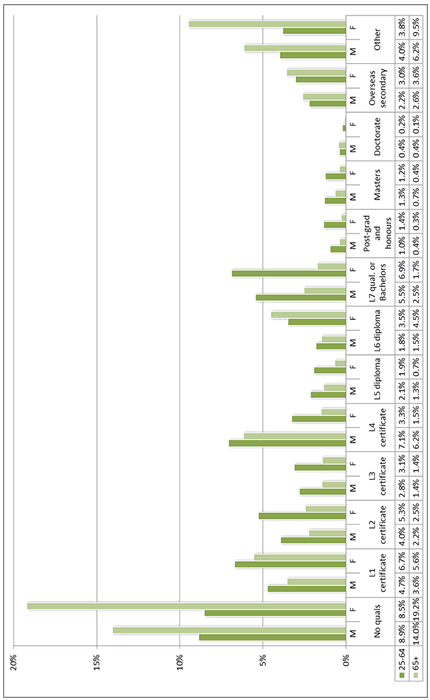Indicator 10: Educational attainment
| Indicator is fully reported? | Yes – data by age and sex is published; total ethnicity data is published; data by age and ethnicity can be requested from Statistics New Zealand. |
| Type of indicator |  Outcome indicator Outcome indicator |
| Other relevant indicators |
Educational attainment in the adult population – defined as distribution of the population aged 25-64 years-old by highest qualification.[1] |
| Our findings |
Higher educational attainment, in terms of recognised qualifications, is associated with a range of positive outcomes, including better income, employment, and health.[2] People are asked about their highest educational attainment in the census, so information is available by age, sex, and ethnicity. Statistics New Zealand produced a series of “quick stats” on a number of topics after the 2006 census, including one on education and training[3] and another on highest educational attainment.[4] We used this data to produce Figure 1, which shows highest educational attainment by age group and sex. It shows that:
The 2006 census data is not easily compared to data from the 2001 and 1996 censuses because of changes in the qualifications framework and questions. It should be possible to compare the 2006 and 2013 census data, once the 2013 data is available. |
| How entities use the data |
Census information is published for general use. The Ministry of Education’s indicator examines the highest level of education completed or achieved within the 25-64 age group. This is often considered a proxy for "human capital", that is, the skills and knowledge in the core working-age population. Changes in educational attainment provide information about access to education and the equity of the education system, and serve as a backdrop to current participation and completion rates. |
| Entity responsible for this indicator |
|
Figure 1: Highest educational attainment by age group, and sex, 2006
This graph shows the proportion of men and women with each qualification as a proportion of the total population in the relevant age group. For example, 14% of the 65+ population were men with no qualifications.

Notes:
-
L = level; qual/quals = qualification(s); post-grad = post-graduate degree.
-
Total population in the 25-64 age group: 2,021,574.
-
Total population in the 65+ age group: 718,431.
-
Percentages rounded to two decimal points.
Source: We prepared this table using data from Table 3 of the data published at www.stats.govt.nz/Census/2006CensusHomePage/QuickStats/quickstats-about-a-subject/education-and-training.aspx.
[1] www.educationcounts.govt.nz/indicators/main/education-and-learning-outcomes/1903.
[2] www.educationcounts.govt.nz/indicators/main/education-and-learning-outcomes/1903.
[3] www.stats.govt.nz/Census/2006CensusHomePage/QuickStats/quickstats-about-a-subject/education-and-training.aspx.
[4] www.stats.govt.nz/Census/2006CensusHomePage/QuickStats/quickstats-about-a-subject/education-and-training/highest-qualification.aspx.

